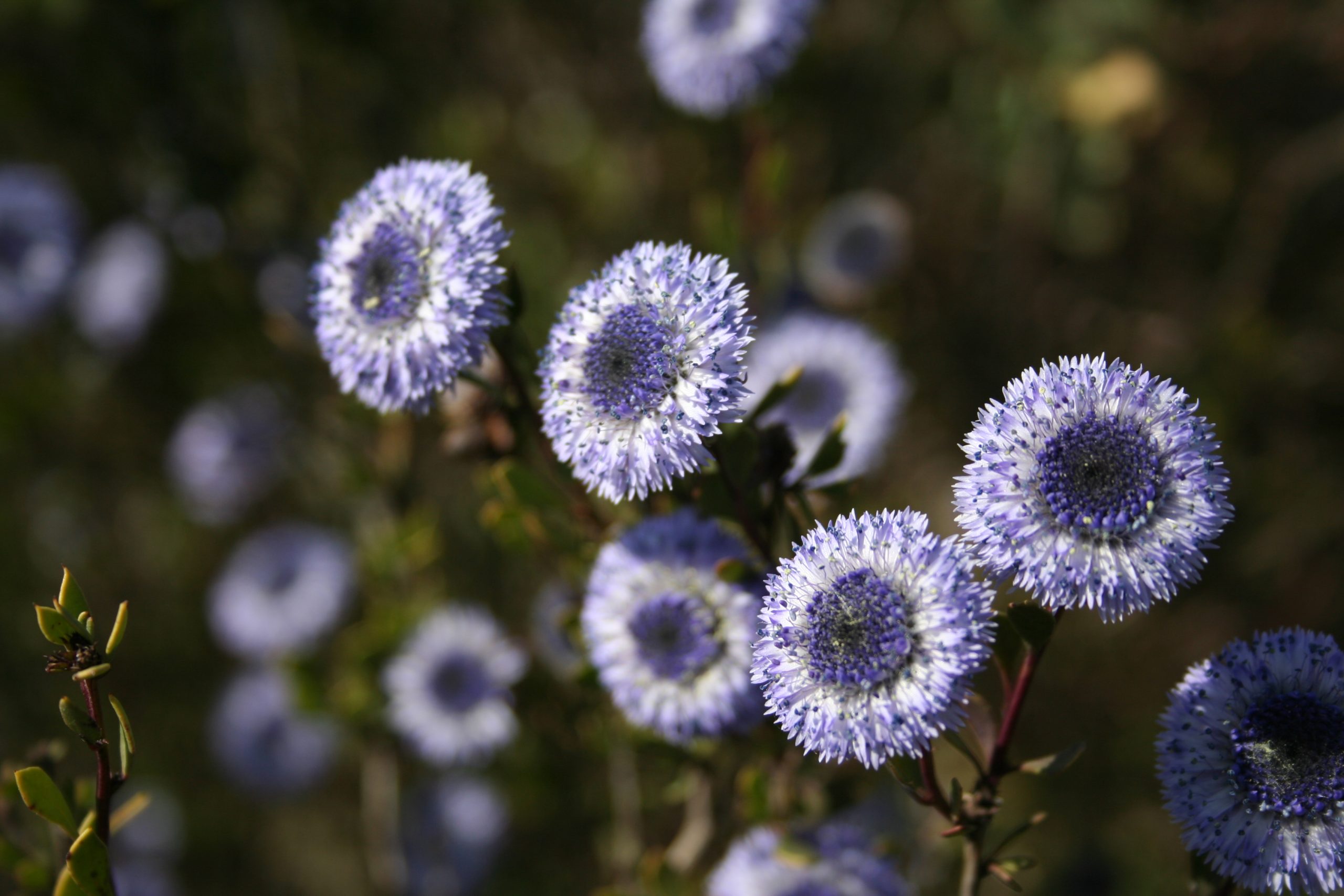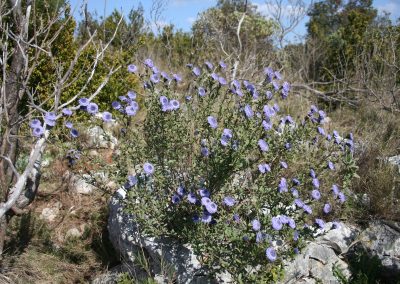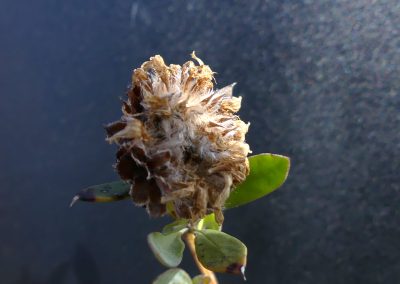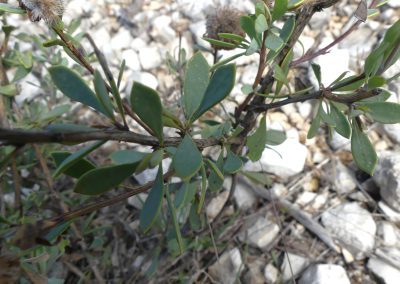Globularia alypum
Scientific description
Taxon: Globularia alypum
Class: Magnoliopsida (Dicotyledons)
Subclass: Asterids
Order: Lamiales
Family: Plantaginaceae (formerly Globulariaceae)
Common name: False alysson globularia
Origin:
Western Mediterranean region.
Description:
Small evergreen shrub under 1 m tall with many upright stems. Leathery, oblong leaves with a single central vein, somewhat sparse and persistent. Flowering from January to March with fragrant blue inflorescences 15–20 mm wide at stem tips.
Propagation:
Mainly by seeds and cuttings; well adapted to dry environments.
Ecology:
Grows in dry, arid habitats such as Mediterranean garrigue along French and Spanish coasts. Prefers poor, well-drained soils.
Uses:
Traditionally used for digestive, purgative, and anti-rheumatic purposes.
Threats:
Least concern globally but vulnerable to habitat loss and land-use change.
Taxon : Globularia alypum
Classe : Magnoliopsidées (Dicotylédones)
Sous-classe : Astéridées
Ordre : Lamiales
Famille : Plantaginacées (anciennement Globulariacées)
Nom commun : Globulaire faux-alysson
Origine :
Région méditerranéenne occidentale.
Description :
Petit arbuste sempervirent de moins d’un mètre avec de nombreuses tiges dressées. Feuilles coriaces, oblongues avec nervure centrale, assez espacées et persistantes. Floraison de janvier à mars avec inflorescences bleues odorantes de 15–20 mm aux extrémités des tiges.
Multiplication :
Principalement par graines et bouturage; bien adapté aux milieux arides.
Écologie :
Pousse dans les milieux secs et arides, notamment garrigue méditerranéenne sur les côtes françaises et espagnoles. Préfère sols pauvres et bien drainés.
Utilisation :
Propriétés digestives, purgatives et antirhumatiques en médecine traditionnelle.
Menaces :
Préoccupation mineure mais sensible à la destruction des habitats et au changement d’usage des terres.
Taxon: Globularia alypum
Clasă: Magnoliopsida (Dikotiledonate)
Subclasă: Asteridae
Ordin: Lamiales
Familie: Plantaginaceae (fost Globulariaceae)
Denumire populară: Globular fals-alysson
Origine:
Regiunea mediteraneană vestică.
Descriere:
Arbust veșnic verde sub 1 m, cu numeroase tulpini verticale. Frunze tari, oblongi, cu o nervură centrală, răsfirate și persistente. Înflorește între ianuarie și martie cu inflorescențe albastre parfumate, 15–20 mm la capătul tulpinilor.
Multiplicare:
Semințe și butași; bine adaptat la medii uscate.
Ecologie:
Crește în medii uscate și aride, în garriga mediteraneană de pe coastele Franței și Spaniei. Preferă soluri sărace și bine drenate.
Utilizare:
Proprietăți digestive, purgative și antireumatice în medicina tradițională.
Amenințări:
Specie de preocupare minimă, vulnerabilă la distrugerea habitatelor și schimbarea utilizării terenurilor.
Ταξινόμηση: Globularia alypum
Κλάση: Δικοτυλήδονα (Magnoliopsida)
Υποκλάση: Αστερίδες
Τάξη: Lamiales
Οικογένεια: Plantaginaceae (πρώην Globulariaceae)
Κοινό όνομα: Ψευδο-αλύσσωνας
Προέλευση:
Δυτική Μεσογειακή περιοχή.
Περιγραφή:
Μικρός αειθαλής θάμνος κάτω από 1 μ., με πολλές όρθιες βλαστούς. Σκληρά, επιμήκη φύλλα με μία κεντρική νεύρωση, αραιά και επίμονα. Ανθίζει Ιανουάριο–Μάρτιο με αρωματικές μπλε ταξιανθίες 15–20 χιλ. στην κορυφή των βλαστών.
Πολλαπλασιασμός:
Κυρίως με σπόρους και μοσχεύματα; καλά προσαρμοσμένο σε ξηρά περιβάλλοντα.
Οικολογία:
Ευδοκιμεί σε ξηρές και άνυδρες περιοχές, όπως η γαργίγια στις γαλλικές και ισπανικές ακτές. Προτιμά φτωχά, καλά στραγγιζόμενα εδάφη.
Χρήση:
Παραδοσιακά για πεπτικά, καθαρτικά και αντιρευματικά.
Απειλές:
Είδος ελάχιστης ανησυχίας, ευαίσθητο στην καταστροφή βιοτόπων και αλλαγές στη χρήση γης.
Creative writing inspired by Globularia alypum
The witch who wanted revenge
Once upon a time, deep in the woods, there lived a woman with evil intentions. Her aim was to poison the inhabitants of her village because they made fun of her, but all her attempts failed.
So one day, she decided to go to the most remote part of her forest, to the edge of a cliff that led straight down to the sea with huge rocks. There she found a plant she'd seen in one of her old books, a bushy globular, a plant with many good qualities, but in high doses it could be toxic and kill anyone. So she picked whole bushes, took them home and cooked them to put in the river near the village, where many people went.
On the big day, something unexpected happened: rain poured down on the village and nobody went to the river. Mad with rage, the young woman went to the river, cursing her village, but through clumsiness, she stumbled and fell into the lake.
From that day on, she was never seen again.






